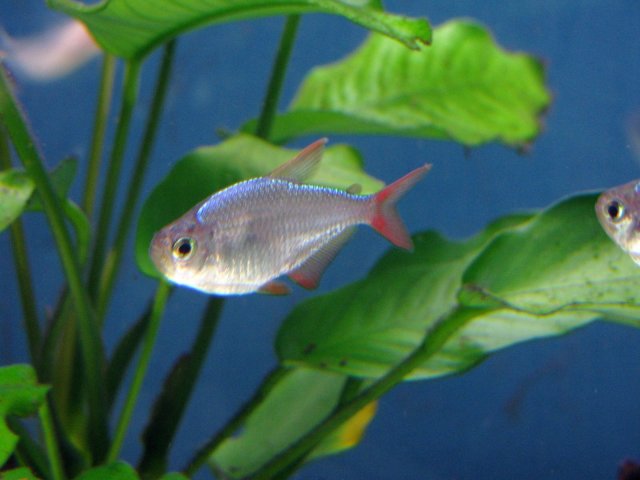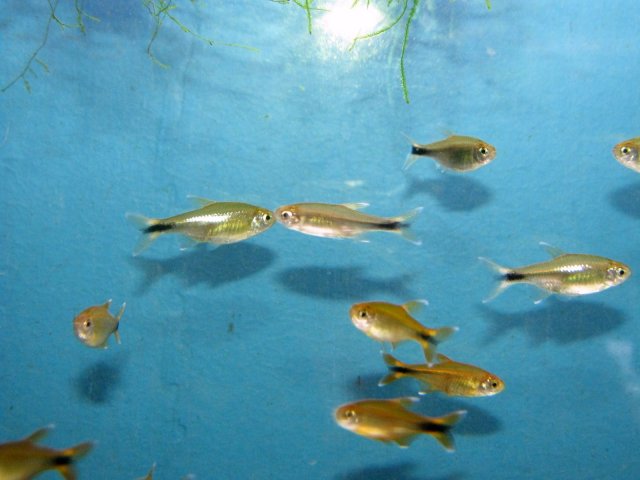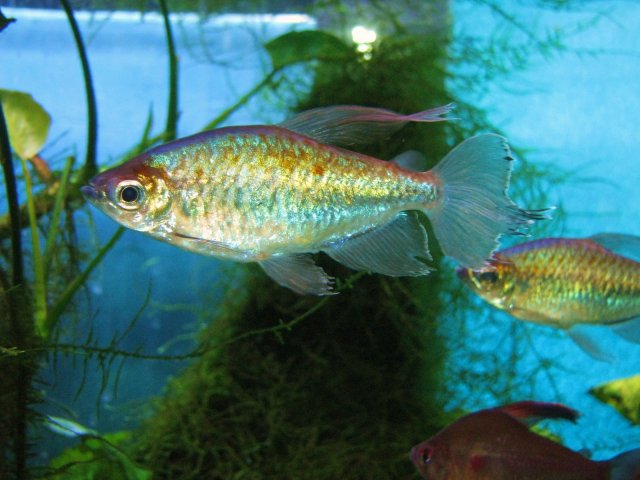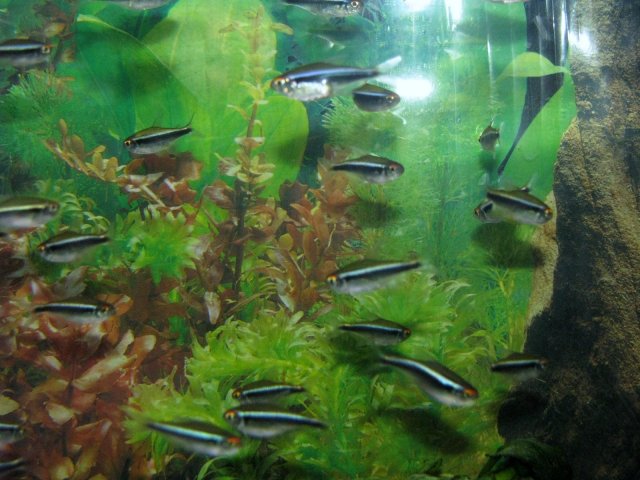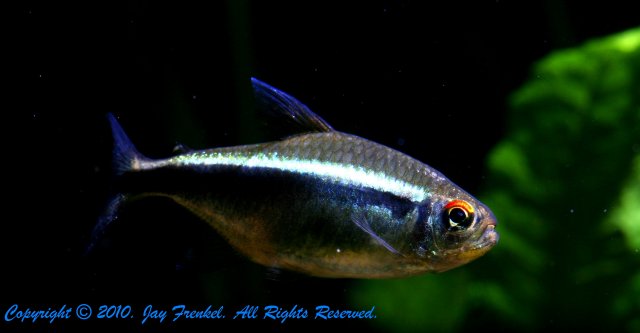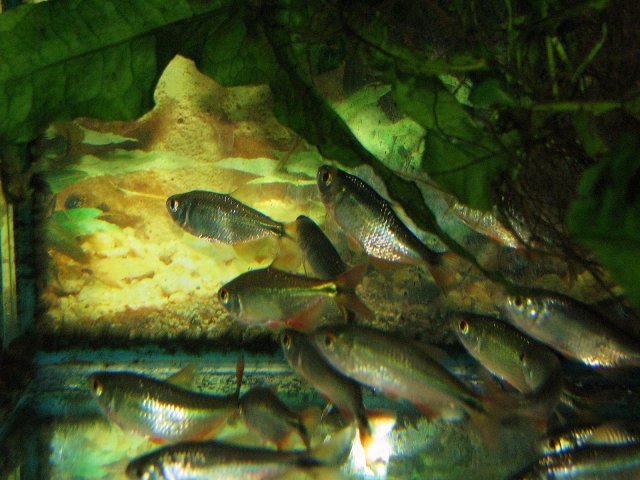Columbian Tetra (Hyphessobrycon columbianus)
Scientific Name: Hyphessobrycon columbianus
Common Name: Columbian Tetra, Blue and Red Tetra, Neon-backed Tetra, Ghost Neon Tetra
Care Level: easy
Size: 2.5 inches
pH Range: 6.5-7.5
Temperature Range: 22-27 degrees Celsius (71-83° F)
Origin: Rio Acandi, Colombia
Temperament: peaceful
Compatible Tankmates:
They make a great addition to the community aquarium. It is highly recommended to keep these fish in schools of six or more. The aquarium should be dimly lit with floating plants and driftwood if available. These fish are only to be kept with other smaller fishes such as other tetra species and corydoras.
Diet:
A good captive diet for
H. columbianus consists of a mixture of balanced flake foods, brine shrimps, bloodworms, and other tiny foodstuff. While Columbian tetras may live for years in a captive environment withiout ever eating anything other than flakes, it is highly recommended supplementing their diet with live/frozen foods as the
H. columbianus will never attain their full flush of beauty and color if they eat only flakes.
Tank Size for Adult: 20g for a group of 8.
Narrative:
According to Phil Purser of the Tropical Fish Magazine, the Columbian tetra was first discovered in a few small streams in the Rio Acandi basin of northern Colombia in the early 1990s. It was initially labeled as
Hyphessobrycon ecuadoriensis which was a mistake considering to anybody's knowledge, no such species exists in the waters of Ecuador. Some hobbyists suggested the taxonomic stratregy of scrapping the genus
Hyphessobrycon altogether and substituting it for
Astyanax, which already includes some large tetras such as the blind cave tetra. This proposal was not however accepted. Finally in 2002, Zarske and Gery stepped up and officially described them as
Hyphessobrycon columbianus.
It must be noted however that most distributors do not use scientific names which are more valid than the common names often shared by more than one species. This can be frustrating especially as the customers try to order such fish and end up receiving another species instead much to their dismay.
Since 2003, the Columbian tetras have grown more popular and large scale breeding projects in captivity have given the wild populations new hope to avoid them from going on the brink of extinction which could happened to species where demand is quite astronomical. The projects since then also lowered demand thus bringing down the selling prices.
Growing to a maximum adult length of just over 2.5 inches,
H. columbianus is a high-backed species. This fish is more laterally flattened than many of its elongate tetra cousins. The dorsal fin is quite tall, even for a tetra, and sweeps back on the dorsal surface. The portion of the back anterior of the dorsal fin is oftentimes raised or humped slightly. Some specimens may have a dorsal fin that is yellow to orange in coloration. The head of
H. columbianus tapers to a rounded spearpoint mouth that is lined with surprisingly large teeth and powerful jaws for such a small fish. The large eyes (proportionally larger than most tetra species) suggest these are active predators whose keen vision is helpful both in spotting prey and avoiding predators. With a narrow muscular caudal peduncle and a tall, sharp-edged caudal fin,
H. columbianus is a powerful swimmer builty for short bursts of rapid speed. The pectoral fins are also anchored in relatively heavy musculature.
The dorsum and upper portions of the sides are bathed in a gentle wash of slightly iridescent pastel blue that will, under superior water conditions, extend downward to encompass the entire lateral surface. Particularl striking specimens will also sport a bright blue swath of the coloration streaking down in the middle of the dorsum. The lower flanks of
H. columbianus are bright metallic silver, and they may act as mirrors in certain lighting situations, catching the blue from higher on the dorsum and reflecting; thus thuis fish may appear entirely blue.
The belly and caudal fin of this fish comprise the red half of the equation. Brginning at the anterior edhe of the anal fin (which is elongate in both sexes of the species), a red coloration fringes the rays, and deepens as it progresses backward. A sort of residual pinkish glow low along the body just above the anal fin (again owing to the mirror-like qualities of the scales along the lateral portions of the body) is also evident in some specimens. The caudal fin, however (and even the caudal peduncle in some specimens), is absolutely awash with fiery bright crimson coloration. As is true with most tropical fish species, these colors may be brighter and more vivid when
H. columbianus is exposed to superior water conditions. Conversely, they will display washed-out or faded coloration in poor water conditions or when otherwise, stressed.
These fish are however tough enough to survive relatively wide ranges of pH and temperature,
H. columbianus are definitely leading competitors for stocking in the beginner's aquarium, as they provide both beauty and longevity (as long as five years). They will thrive in pH ranging from 6.5 to 7.5 and will tolerate from 71 to 83 degrees Fahrenheit.
Mid to upper level swimmers, these little tetras are highly active during the daylight hours, and perhaps even more son on moonlit nights. In the wild,
H. columbianus often feeds on aquatic insects and larva. To catch these foods, the fish sometimes must leap out of the water or make quick dashes to the top of the water column-acts that may lead to fatal leaps from your tank. Even a covered tank is not absolute security, however, as these little rascals can get quite raucous around feeding time. So take care not to lift a glass lid too high or leave it open when you feed, as it is very easy for a Columbian tetra to jump out of the tank even with you standing right there.
These fish do best in heavily planted tanks and/or those with ample amouts of driftwoods or other hiding places. In their native environment, predators are all too common and any
H. columbianus that cannot find quick cover are easy targets. Lack of driftwood and underwater vegetation will severely stress these fish, as too much open water is not in their porgram for survival in the wild. In fact, a lack of adequate wooden, stone or vegetative cover may also increase the fish's propensity for leaping out of the water; even with a lidded tank that prevents escape, a fish may still be injured if it hits a glass lid on a jump.
A good captive diet for
H. columbianus consists of a mixture of balanced flake foods, brine shrimps, bloodworms, and other tiny foodstuff. While Columbian tetras may live for years in a captive environment withiout ever eating anything other than flakes, it is highly recommended supplementing their diet with live/frozen foods as the
H. columbianus will never attain their full flush of beauty and color if they eat only flakes.
According to Phil Purser, it seems that
H. columbianus have attained themselves the reputation of being devious, fin-nipping, and generally riotous members of the tetra family. Some hobbyists tell tales of these fish chasing nad harassing larger barbs, tetras, poeciliids and even catfish. Some even reported outlandish incidents of these fish having a fiery enough temper to actually bully the mouth and lips of larger fish in order to force that fish to spit out food it had jsut eaten. After the harassed fish surrendered its mouthful, the
H. columbianus would feed on the spit-out bits.
These fish can certainly be overwhelming to slow-moving specimens. Mix them with fast moving tetras such as neons, rummynoses, danios and barbs.
H. columbianus also mix quite well with most catfishes and loaches. Most
H. columbianus simply will not dive to the lowermost depths of the aquarium, and so don't typically cross paths with the bottom-dwelling fish.
These fish are listed as 'egg-scatterers'. Females are not very picky about deposition sites. In the wild, females will deposit their eggs directly into the currents of the stream, thus scattering them as far as the flowing water will carry them. These manner avoids predation which however is another story if done in captivity.
Reference: Purser, Phil ; Tropical Fish Hobbyist (Jan 2008).
